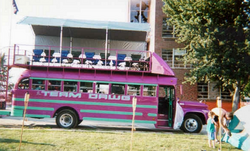Deaths
Over the first 42 years of the ride (through 2014), 30 deaths of ride participants or volunteers have officially occurred during the week of RAGBRAI because of accidents or injuries suffered on the ride. [26] Although the event began in 1973, the first death did not occur until RAGBRAI XII in 1984. [27] Many of the deaths were due to heart attacks that riders suffered while resting. However, in Sheldon on the first night of the 2005 ride, a weather-related fatality occurred as Michael Thomas Burke (a native of Donnellson, Iowa and an industrial engineering graduate from the University of Iowa, who was living in New York City) died when a storm caused a tree limb to fall on him as he was sleeping in a tent. [28]
Only a few deaths resulted from injuries sustained while actually riding on bicycles. The first was in 1987, when 19-year-old John Boyle of Rockwell City was run over by a flatbed trailer. [29] On Monday, July 30, 2007, at 12:52 pm, a Waterloo man, who was rescued from the Wapsipinicon River in Independence, subsequently died; 62-year-old Rich Droste had been participating in RAGBRAI, which made an overnight stop in Independence on Thursday. Droste was swimming in the Wapsi when he apparently got caught in the current upstream from the dam. On July 25, 2009, Donald D. Myers from Rolla, Missouri, died of injuries sustained in a crash at the bottom of the hill near Geode Lake dam at Geode State Park. [30] [31] [32] [33] On July 30, 2010, Stephen Briggs of Waverly, Iowa died after his bike clipped the tire of another bike and he was thrown from his bike. [34]
After Briggs' death, no more fatalities occurred until 2014, when on Monday, July 21, Tom Teesdale, 62, of West Branch died of a heart attack between Terril and Graettinger, and on Wednesday, July 23, 74-year old George 'Frank' Brinkerhoff of Sioux City died of natural causes and was found dead in his tent Thursday morning. [26] [35] [36] [37] [38]
On Sunday, July 24, 2016, at the 2-mile marker on US Highway 34 near Glenwood, Wayne Ezell, 72, of Jacksonville, Florida, was westbound when a pickup truck driven by Robb Philippus, 34, of Glenwood, hit him from behind about 6:40 am. Ezell, who died from his injuries sustained during the accident, was a rider participating in RAGBRAI XLIV. [39] Also, in 2016, on the Tuesday of RAGBRAI XLIV, a 60-year-old RAGBRAI rider, Clifton Kahler, had a heart attack while riding along Highway 2 between Creston and Leon and died. [40] [41]
In 2023 on RAGBRAI L, a rider in his 50s had a medical emergency while riding his bicycle on the route on Tuesday day 3 of RAGBRAI between Carroll and Ames near the intersection of J Avenue and 270th Street in Boone County at approximately 1:16 p.m. but did not survive after being transported in an ambulance from the scene. [42]
During RAGBRAI LII in 2025, two deaths occurred. [43] [44] [45] On Monday July 21, 2025, which was day 2 of RAGBRAI LII, 62-year old Mark R. Spoo of Colorado collapsed at 8:15 am while riding his bicycle on the RAGBRAI route in Jackson County, Minnesota, west of MN 86 on Jackson County Road 4. [44] [45] [46] Within seconds, he was immediately attended by a doctor, surgeon, and a physician's assistant, who were all RAGBRAI riders, and was transported by Lakefield Ambulance Service to the nearby Lakes Regional Medical Center at Spirit Lake, Iowa, where he was pronounced dead. [46] [45] [47] On Tuesday morning July 22, 2025, which was day 3 of RAGBRAI LII, 63-year old Thomas McCarthy of Arizona, who was a RAGBRAI rider riding the RAGBRAI route, was vomiting near South 8th Street and 1st Avenue South in central Estherville, Iowa. [43] [48] Police officers were notified at 7:40 am, but, when they arrived, the victim was unconscious and had no pulse. [43] McCarthy received CPR and an automated external defibrillator (AED) was administered to revive him at the scene. [43] [45] He was transported by the Estherville Ambulance Service to nearby Avera Holy Family Hospital in Estherville where he was pronounced dead. [43] [44] [45] [48]
A plane carrying a pilot and a young Canadian woman who was making a documentary about the ride crashed during the course of the 2005 RAGBRAI. In this case, the pair suffered minor injuries. Pilot Jim Hill of Manchester, Iowa, and Amy Throop of Ottawa, Canada, were following the route on a plane near Riceville, Iowa, when the plane went down. Both Hill and Throop walked away from the accident. Throughout the ride, ultralights have flown over riders a few feet above the trees to get good shots of the riders.


